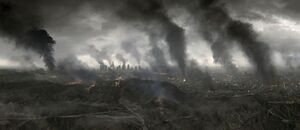Battle of Khov
| Battle of Khov | |||||||
|---|---|---|---|---|---|---|---|
| Part of Operation Zydron | |||||||
 Khov skyline during the battle. | |||||||
| |||||||
| Belligerents | |||||||
|
|
| ||||||
| Commanders and leaders | |||||||
|
|
| ||||||
| Units involved | |||||||
|
Daxian Armed Forces Peace Brigade | 1st, 2nd and 3rd Strike Divisions | ||||||
| Strength | |||||||
|
36,000 50,000 by September | 16,800 | ||||||
| Casualties and losses | |||||||
| Unknown | Over 10,000 | ||||||
The Battle of Khov was a battle between the forces of the Daxian government and the communist rebels of the Army of Common Men. Following the communist summer offensive in 1996 and the capture of Khov, government forces prepared Operation Zydron to push them back, retake the city and destroy their ad-hoc 'Khov Socialist Republic'. The battle is remembered for the brutality of both sides during the fierce urban fighting and the tremendous toll on civilian lives. In the aftermath of its defeat at Khov, the Army of Common Men was spent as a military force of any significance and returned to clandestinity.
Background
By mid-1993 the BSP had been given the directive to begin the repression of the Army of Common Men. Operation Dendron decapitated most of the communist political leadership and left the party directionless however the cell structure of the ACM prevented it from being destroyed. This operation also had the secondary effect of rendering the political path almost irrelevant in the conflict to come by demonstrating that there was no way back into mainstream politics for communist currents. Dendron marked the beginning of a bloody period of state terrorism as the government sought to crush the armed resistance of the ACM by any means necessary. Hundreds of thousands of left-wing activists, students, journalists, writers and anyone suspected of sympathizing with the political left were imprisoned, tortured and killed. The ACM responded by unleashing a wave of terrorist bombings, hit and run attacks on military and police targets and killing of government employees as reprisals. Increasing efficiency in intel gathering on the ACM resulted in the design and implementation of Operation Eschaton, which succeeded in killing hundreds of leadership figures all across the country. Finding itself increasingly cornered in urban areas by the security organs, the bulk of the ACM moved into the countryside whilst leaving only smaller three-man cells in the cities.
In rural areas the organization had a degree of grassroots support, especially in the poorer west part of the country. PDD initiated security reforms had not yet reached these locales and the local security forces were too weak to suppress the ACM on their own. While the ACM had appeared to be on the backfoot or even the edge of defeat at the end of 1995, its move to the countryside allowed it breathing room to reconstitute itself and Operation Eschaton had not yet taken an irreversible toll. It coerced peasants to join its force in increasing numbers and began expanding an area of actual territorial control that surrounded several provincial cities. By the summer of 1996 the ACM had recovered in numbers and stormed the city of Khov, defeating the local garrison and with the local police force fleeing without a fight. The ACM declared a Khov Socialist Republic and invited the 'revolutionary' sectors of the city to join its forces. Khov being one of the largest industrial cities in western Daxia was home to dozens of industrial complexes employing hundreds of thousands of workers, susceptible to ACM propaganda and enticements. With support inside the city, the ACM settled in for a protracted urban siege where it hoped to grind down government forces.
Opposing forces
Army of Common Men
The Army of Common Men deployed the majority of its regular fighting force for the battle over the city, around 16,800 people in total. Organized into three so-called 'Strike Divisions' of approximately 5,600 men each. The 1st and 2nd divisions formed the experienced and battle hardened core of the organization while the 3rd drew heavily on Khov's industrial workers to fill out its ranks. The ACM had few heavy weapons at its disposal, it had around one hundred mortars and a couple dozen towed artillery; it used components found in the city's industrial factories to cobble together explosive devices and rockets. As for armored vehicles it had access to several dozen armored carriers and tanks it captured from government forces and enough fuel from the city's synthetic plants. More numerous were the technicals with mounted machine guns and anti tank weapons which were used extensively in the fighting.
Government forces
The government deployed several mechanized brigades from the far western military district for operations around and inside Khov. These forces were fairly well equipped with modern weaponry and vehicles albeit they were mostly untested in combat. The BSP and Peace Brigade also deployed alongside the regular army forces, these forces were more experienced in counter insurgency and would prove essential to breaching the city's defenses. The government had an absolute superiority in artillery and total control of the air, Khov would be bombarded for the entire duration of the siege.